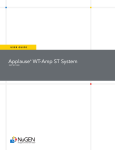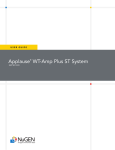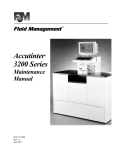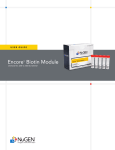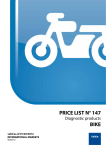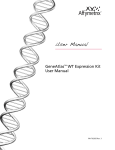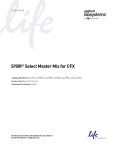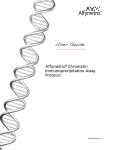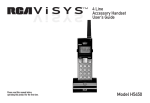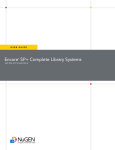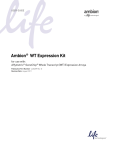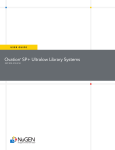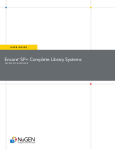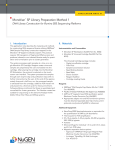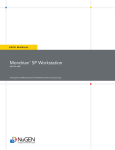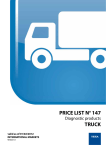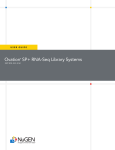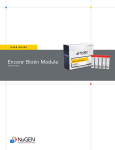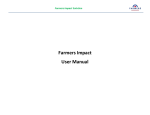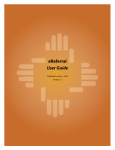Download NuGen Applause™ WT
Transcript
USER GUIDE Applause™ WT-Amp ST System PART NO. 5500 Patents, Licensing and Trademarks © 2009–2011 NuGEN Technologies, Inc. The Ovation® and Applause families of products and methods are covered by U.S. Patent Nos. 6,692,918, 6,251,639, 6,946,251 and 7,354,717, and other issued and pending patents in the U.S. and other countries. NuGEN, the NuGEN logo, Ovation, SPIA, Ribo-SPIA, WT-Ovation, Encore, Applause, Prelude and Imagine More From Less are trademarks or registered trademarks of NuGEN Technologies, Inc. Other marks appearing in these materials are marks of their respective owners. The purchase of this product conveys to the buyer the limited, non-exclusive, non-transferable right (without the right to modify, reverse engineer, resell, repackage or further sublicense) under these patent applications and any patents issuing from these patent applications to use this product and methods, accompanying this user guide, for research and development purposes solely in accordance with the intended use described and the written instructions provided in this user guide. No license to make or sell products by use of this product is granted to the buyer whether expressly, by implication, by estoppels or otherwise. In particular, the purchase of this product does not include or carry any right or license to use, develop or otherwise exploit this product commercially and no rights are conveyed to the buyer to use the product or components of the product for purposes including commercial services or clinical diagnostics. For information on purchasing a license to the NuGEN patents for uses other than in conjunction with this product or to use this product for purposes other than research, please contact NuGEN Technologies, Inc., 201 Industrial Road, Suite 310, San Carlos, CA 94070. Phone (888-654-6544 or 650-590-3600); FAX (888-296-6544 or 650-590-3630). Warranty NuGEN warrants that this product meets the performance standards described in the Company’s product and technical literature for a period of six months from the date of purchase, provided that the product is handled and stored according to published instructions, and that the product is not altered or misused. If the product fails to meet these performance standards, NuGEN will replace the product free of charge or issue a credit for the purchase price. NuGEN’s liability under this warranty shall not exceed the purchase price of the product. NuGEN shall assume no liability for direct, indirect, consequential or incidental damages arising from the use, results of use or inability to use its products. NuGEN reserves the right to change, alter or modify any product to enhance its performance and design. NuGEN’s products are developed, designed and sold FOR RESEARCH USE ONLY. This product is not to be used for diagnostic or drug purposes, nor is it to be administered to humans or animals. Except as expressly set forth herein, no right to modify, reverse engineer, distribute, offer to sell or sell NuGEN’s product is conveyed or implied by buyer’s purchase of this NuGEN product. The buyer agrees to use NuGEN products accompanying the product insert in accordance with the intended use and the written instructions provided. Table of Contents Contents I.Introduction.......................................................................................................... 1 A.Background........................................................................................................ 1 B. How the Applause WT-Amp ST System Works ................................................. 1 C. Performance Specifications................................................................................ 3 D. Quality Control .................................................................................................. 3 E. Storage and Stability.......................................................................................... 3 F. Material Safety Data Sheet (MSDS).................................................................... 3 II. Kit Components................................................................................................... 4 A. Reagents and Supplies Provided....................................................................... 4 B. Additional Reagents, Supplies and Equipment ................................................ 5 III. Planning the Experiment...................................................................................... 7 A. Input RNA Requirements................................................................................... 7 B. Using RNase-free Techniques............................................................................ 8 C. RNA Storage...................................................................................................... 8 D. Amplified cDNA Storage................................................................................... 8 IV. Amplification Protocols........................................................................................ 9 A.Overview............................................................................................................ 9 B. Protocol Notes................................................................................................... 9 C. Programming the Thermal Cycler.................................................................... 11 D. First Strand cDNA Synthesis............................................................................ 12 E. Second Strand cDNA Synthesis....................................................................... 13 F. Post-Second Strand Enhancement.................................................................. 14 G.SPIA® Amplification ......................................................................................... 15 H. Post-SPIA Modification I ................................................................................. 16 I. Post-SPIA Modification II ................................................................................ 17 J. Purification of ST-cDNA ................................................................................... 17 K. Measuring ST-cDNA Yield and Purity............................................................... 19 V. Labeling Targets for Affymetrix GeneChip Gene 1.0 ST Arrays......................... 20 A. Encore™ Biotin Module Overview .................................................................. 20 B. Protocol Notes ................................................................................................ 20 C. Preparing cDNA Samples ............................................................................... 20 D. Programming the Thermal Cycler.................................................................... 21 E. cDNA Fragmentation ...................................................................................... 21 F. Biotin Labeling................................................................................................. 22 Applause™ WT-Amp ST System Table of Contents VI. Technical Support................................................................................................ 23 VII.Appendix............................................................................................................ 24 A. Target Preparation for GeneChip Gene 1.0 ST Array Hybridization................ 24 B. Performing Quantitative PCR on Amplified cDNA.......................................... 25 C. Quality Control of Amplified cDNA Product.................................................... 26 D. DNase Treatment of RNA................................................................................ 26 E. Frequently Asked Questions (FAQs)................................................................ 30 F. Update History................................................................................................. 34 Applause™ WT-Amp ST System I.Introduction A. Background The Applause™ WT-Amp ST System provides a fast, simple and cost-effective method for preparing amplified cDNA for global gene expression analysis on Affymetrix® GeneChip® Gene 1.0 ST Arrays. Powered by Ribo-SPIA® technology, a rapid, simple and sensitive RNA amplification process developed by NuGEN, the Applause WT-Amp ST System enables the generation of microgram quantities of cDNA in approximately seven hours. Amplification is initiated at the 3´ end as well as randomly throughout the transcriptome, making the Applause WT-Amp ST System an ideal choice for use with whole transcript array designs such as the Gene 1.0 ST Array. The Applause WT-Amp ST System (Part No. 5500) provides optimized reagent formulations and a protocol to process total RNA samples. B. How the Applause WT-Amp ST System Works The Applause WT-Amp ST System utilizes Ribo-SPIA technology that produces amplified cDNA from total RNA (see Figure 1). 1. Generation of First Strand cDNA (1 hour) First strand cDNA is prepared from a minimum of 50 ng of high-quality total RNA sample using a unique first strand DNA/RNA chimeric primer mix and reverse transcriptase (RT). The primers have a DNA portion that hybridizes either to the 5´ portion of the poly(A) sequence or randomly across the transcript. RT extends the 3´ DNA end of each primer generating first strand cDNA. The resulting cDNA/ mRNA hybrid molecule contains a unique RNA sequence at the 5´ end of the cDNA strand. 2. Generation of a DNA/RNA Heteroduplex Double-stranded cDNA (1.5 hours) Fragmentation of the mRNA within the cDNA/mRNA complex creates priming sites for DNA polymerase to synthesize a second strand, which includes DNA complementary to the 5´ unique sequence from the first strand chimeric primers. The result is a double-stranded cDNA with a unique DNA/RNA heteroduplex at one end. 3. SPIA® Amplification (1.5 hours) SPIA amplification is a linear isothermal DNA amplification process developed by NuGEN. The process uses a SPIA DNA/RNA chimeric primer, DNA polymerase and RNase H in a homogeneous isothermal assay that provides highly efficient amplification of DNA sequences. RNase H degrades RNA in the DNA/RNA heteroduplex at the 5´ end of the first cDNA strand. This exposes a DNA sequence that is available for binding to the SPIA DNA/RNA chimeric primer. DNA polymerase initiates replication at the 3´ end of the primer, displacing the existing forward strand. The RNA portion at the 5´ end of the newly synthesized strand is again removed by RNase H, exposing the unique priming site for initiation of the next round of cDNA synthesis. The process of SPIA DNA/RNA primer binding, DNA replication, strand displacement and RNA cleavage is repeated, resulting in rapid accumulation of cDNA with sequence complementary to the original mRNA. 1 Applause™ WT-Amp ST System I.Introduction 4. Post-SPIA Modification, Purification and QC (3 hours) The Post-SPIA Modification process completes the amplification process. The first step allows the random primers to anneal to the single-stranded, antisense cDNA target. The second step utilizes DNA polymerase to extend the annealed primers, producing ST-cDNA targets appropriate for use with GeneChip Gene 1.0 ST Arrays. Figure 1. The Ribo-SPIA Whole Transcriptome RNA Amplification Process The Ribo-SPIA® WT-Amp Process AAAA 3´ 5´ 3´ TTTT First Strand cDNA Synthesis RT NNNNNN 5´ DNA 5´ SPIA Product Reverse Transcriptase RT WT Primer (DNA/RNA) NNNNNN SPIA Primer (DNA/RNA) AAAA 3´ TTTT 5´ RT RNA 5´ 3´ NNNNNN 5´ TTTT Oligo dT Primer (DNA/RNA) NNNNNNNNN Random 9-mer Second Strand cDNA Synthesis Pol DNA Polymerase RT 5´ 3´ 3´ 5´ Reverse Transcriptase Pol DNA Polymerase H RNAseH RNAseH cleavage of RNA Sequence 5´ 3´ 5´ 3´ H RNAseH SPIA Reaction Pol DNA Polymerase SPIA Primer Linear Amplification 3´ 5´ Pol Pol Pol 5´ Pol RNAseH Cleavage to Free Primer Hybridization Site 3´ 5´ 5´ Pol H RNAseH Primer Extension by Strand Displacement DNA Synthesis 5´ Pol Pol 3´ 5´ Primer Extension by DNA Polymerase 3´ 5´ 5´ Pol Post-SPIA Modification (ST-cDNA Production) 5´ 3´ SPIA Product NNNNNNNNN Random Primer Pol DNA Polymerase 5´ Pol 2 Applause™ WT-Amp ST System 3´ NNNNNNNNN Pol NNNNNNNNN I.Introduction C. Performance Specifications The Applause WT-Amp ST System synthesizes microgram quantities of ST-cDNA starting with a total RNA input of at least 50 ng. In approximately seven hours, the system produces sufficient cDNA for labeling and subsequent hybridization to Affymetrix Gene 1.0 ST Arrays. The size of the majority of the cDNA products produced by the amplification process is between 0.1 and 2.0 kilobases. D. Quality Control Each Applause WT-Amp ST System lot is tested to meet specifications of yield and array performance. E. Storage and Stability The Applause WT-Amp ST System is shipped on dry ice and should be unpacked immediately upon receipt. All components should be stored at –20°C in a freezer without a defrost cycle. This product has been tested to perform to specifications after as many as six freeze/ thaw cycles. Kits handled and stored according to the above guidelines will perform to specifications for at least six months. NuGEN has not yet established long-term storage stability for the Applause WT-Amp ST System. F. Material Safety Data Sheet (MSDS) An MSDS for this product is available from NuGEN Technical Service by calling 888‑654-6544 or by sending an email to: [email protected]. 3 Applause™ WT-Amp ST System II. Kit Components A. Reagents and Supplies Provided Table 1. First Strand cDNA Reagents COMPONENT PART NUMBER VIAL CAP VIAL NUMBER First Strand Primer Mix S01262 Blue A1 ver 4 First Strand Buffer Mix S01256 Blue A2 ver 3 First Strand Enzyme Mix S01040 Blue A3 ver 1 Table 2. Second Strand cDNA Reagents COMPONENT PART NUMBER VIAL CAP VIAL NUMBER Second Strand Buffer Mix S01257 Yellow B1 ver 3 Second Strand Enzyme Mix S01126 Yellow B2 ver 2 Enhancement Enzyme Mix S01119 Yellow B3 ver 1 COMPONENT PART NUMBER VIAL CAP VIAL NUMBER SPIA Primer Mix S01264 Red C1 ver 8 SPIA Buffer Mix S01259 Red C2 ver 8 SPIA Enzyme Mix S01261 Red C3 ver 5 Table 3. SPIA Reagents 4 Applause™ WT-Amp ST System II. Kit Components Table 4. Post-SPIA Modification Reagents COMPONENT PART NUMBER VIAL CAP VIAL NUMBER Primer Mix S01268 Violet E1 ver 1 Buffer Mix S01269 Violet E2 ver 2 Enzyme Mix S01270 Violet E3 ver 1 PART NUMBER VIAL CAP VIAL NUMBER S01001 Green D1 Table 5. Additional Reagents COMPONENT Nuclease-free Water Note: The reagents in the Applause WT-Amp ST System are similar to reagents in NuGEN’s other kits. However, unless the part numbers are identical, these reagents do not have exactly the same composition and, therefore, are not interchangeable. Do not exchange reagents between different kits, as it will adversely affect performance. B. Additional Reagents, Supplies and Equipment Required Materials • Equipment -- Microcentrifuge for individual 1.5 mL and 0.5 mL tubes -- Microcentrifuge or centrifuge for individual 0.2 mL tubes, strip tubes and PCR plates -- 0.5–10 µL pipette, 2–20 µL pipette, 20–200 µL pipette, and 200–1000 µL pipette -- Vortexer -- Thermal cycler with 0.2 mL tube heat block, heated lid, and 100 µL reaction capacity -- Appropriate spectrophotometer and cuvettes, or a Nanodrop® UV-Vis Spectrophotometer • Reagents -- Ethanol (Sigma-Aldrich, Cat. #E7023), for purification steps 5 Applause™ WT-Amp ST System II. Kit Components • Supplies and Labware -- Nuclease-free pipette tips -- 1.5 mL and 0.5 mL RNase-free microcentrifuge tubes -- 0.2 mL individual thin wall PCR tubes, 8 X 0.2 mL strip PCR tubes or 0.2 mL thin wall PCR plates -- QIAGEN® MinElute® Reaction Cleanup Kit (Cat. #28204) -- Disposable gloves -- Kimwipes -- Ice bucket Optional Materials • Agilent® 2100 Bioanalyzer or materials and equipment for electrophoretic analysis of RNA • Real Time PCR system • Cleaning solutions such as RNaseZap® (Ambion, Cat.#AM9780) and DNAOFF™ (MP Biomedicals, Cat.#QD0500) To Order: • • • • • • 6 Applause™ WT-Amp ST System Ambion Inc., www.ambion.com MP Biomedicals, www.mpbio.com New England BioLabs, www.neb.com QIAGEN Inc., www.qiagen.com Sigma-Aldrich, Inc., www.sigmaaldrich.com USB Corporation, www.usbweb.com III.Planning the Experiment A. Input RNA Requirements It is important to assess the quality of your RNA sample prior to planning your amplification. The Applause WT-Amp ST System is designed to be used with high quality RNA samples. 1. RNA Quantity The Applause WT-Amp ST System is designed to use purified total RNA samples in the input range from 50 to 200 ng. 2. RNA Purity Purified total RNA samples must be free of contaminating proteins and other cellular material, organic solvents (including phenol and ethanol) and salts used in many RNA isolation methods. Use of a commercially available system for preparation of RNA that does not require organic solvents is recommended. If a method such as TRIzol® is used, we recommend employing an additional column purification step after isolation in order to remove any residual organics. One measure of RNA purity is the ratio of absorbance readings at 260 and 280 nm. The A260:A280 ratio for RNA samples of acceptable purity should be in excess of 1.8. RNA samples with lower ratios may result in poor amplification. 3. RNA Integrity Purified total RNA samples of high molecular weight with little or no evidence of degradation are required for use with this product. RNA integrity can be determined using the Agilent 2100 Bioanalyzer, RNA 6000 Nano LabChip® or RNA 6000 Pico LabChip. The RNA Integrity Number (RIN), available in the Bioanalyzer 2100 Expert Software, provides an index of RNA quality that can be helpful in triaging purified RNA samples of varying integrity prior to amplification. Figure 2. This illustration of RNA quality variation shows Bioanalyzer traces of three different RNAs with varying degrees of quality. RNA Quality Continuum Poor Quality RIN=2.4 7 Applause™ WT-Amp ST System Moderate Quality RIN=6.7 Good Quality RIN=9.2 III.Planning the Experiment 4. User Quality Control Guidelines for RNA samples The inclusion of positive control RNA samples is an essential tool in evaluating the success of an amplification experiment. In the absence of successful positive control RNA amplification, it may be difficult or impossible to troubleshoot amplification issues. 5. DNase Treatment The use of DNase-treatment is highly recommended when using purified RNA samples. Contaminating genomic DNA will interfere with accurate quantitation of RNA samples and may negatively impact detection sensitivity and data quality. Refer to the Appendix for examples of DNase treatment protocols that have been used successfully. 6. Carrier use for RNA isolation We strongly recommend against the use of nucleic acid based carriers during RNA purification because many have been shown to produce cDNA product in first strand synthesis. We also advise against the use of glycogen in RNA isolation, as it inhibits reverse transcription. For the latest information regarding other carriers, contact our technical services team. B. Using RNase-free Techniques RNase contamination through reagents and work environment will lead to experimental failure. Follow these guidelines to minimize RNases in the workspace: 1. Wear disposable gloves and change them frequently. 2. Avoid touching surfaces or materials that could introduce RNases. 3. Use reagents provided. Substitutions may introduce RNases. 4. Clean work areas and instruments, including pipettes, with commercially available cleaning reagents, such as RNaseZap. 5. Use only new RNase-free pipette tips and microcentrifuge tubes. 6. Use a work area specifically designated for RNA work and do not use other high copy number materials in the same area. C. RNA Storage RNA samples should be stored at –80°C. Avoid frequent freeze/thaw cycles of RNA, as RNA degradation may result. D. Amplified cDNA Storage The amplified ST-cDNA produced by the Applause WT-Amp ST System may be stored at –20°C. 8 Applause™ WT-Amp ST System IV.Amplification Protocols A. Overview The Ribo-SPIA amplification process used in the Applause WT-Amp ST System is performed in five stages: 1.First strand cDNA synthesis 1 hour 2.Second strand cDNA synthesis and enhancement 1.5 hours 3.SPIA isothermal linear amplification 1.5 hours 4.Post-SPIA modification 2 hours 5.cDNA purification and quantitation 1 hour Total time to prepare amplified cDNA ~7 hours Applause components are color coded, with each reagent vial linked to a specific process stage. Performing each stage requires the simple addition of a master mix or other reagents, followed by incubation. Master mixes are prepared by mixing components provided for that stage. B. Protocol Notes • It is important to set up no fewer than eight reactions at a time. This will ensure that you are not pipetting very small volumes (see the second strand synthesis section) below the effective range of air displacement pipetting technologies. For this reason, setting up fewer than eight reactions can lead to poor performance. • Thaw components used in each step and immediately place them on ice as indicated in this user guide. It is best not to thaw reagents for all steps at once. The reagent color coding can be a guideline for appropriate reagent grouping. • Always keep thawed reagents and reaction tubes on ice unless otherwise instructed. • After thawing and mixing buffer mixes, in rare instances a precipitate is observed. It is important that it be re-dissolved completely prior to use. You may gently warm the Buffer Mix for two minutes at room temperature followed by brief vortexing. Do not warm any enzyme or primer mixes. • When placing small amounts of reagents into the reaction mix, pipet up and down several times to ensure complete transfer. • When instructed to pipet mix, gently aspirate and dispense a volume that is at least half of the total volume of the reaction mix. • Always allow the thermal cycler to reach the initial incubation temperature prior to placing the tubes or plates in the block. 9 Applause™ WT-Amp ST System IV.Amplification Protocols • When preparing master mixes, use the minimal amount of extra material to ensure there are sufficient reagents for 24 reactions. Typically an overage factor of 10% is acceptable. For example, if making a master mix for eight reactions use a factor of 8.8x when calculating the master mix volumes. • Components and reagents from other Ovation® System, WT-Ovation™ System or Applause System products should not be used with this product. • Caution: The Enhancement Enzyme Mix, B3 (patent pending) contains a heatlabile RNase I enzyme. When using this reagent take care not to splash or contaminate gloves, bench or pipettes. Preferably use a dedicated pipette to measure out B3. 10 Applause™ WT-Amp ST System IV.Amplification Protocols C. Programming the Thermal Cycler Use a thermal cycler with a heat block designed for 0.2 mL tubes, equipped with a heated lid, and with a capacity of 100 µL reaction volume. Prepare the programs shown in Table 6, following the operating instructions provided by the manufacturer. For thermal cyclers with an adjustable heated lid, set the lid temperature at 100°C. For thermal cyclers with a fixed temperature heated lid (e.g., ABI GeneAmp® PCR 9600 and 9700 models) use the default settings (typically 100 to 105°C). Table 6. Thermal Cycling Protocols FIRST STRAND cDNA SYNTHESIS Program 1 Primer Annealing 65°C – 5 min, hold at 4°C Program 2 First Strand Synthesis 4°C – 1 min, 25°C – 10 min, 42°C – 10 min, 70°C – 15 min, hold at 4°C SECOND STRAND cDNA SYNTHESIS Program 3 Second Strand Synthesis 4°C – 1 min, 25°C – 10 min, 50°C – 30 min, 70°C – 5 min, hold at 4°C POST-SECOND STRAND ENHANCEMENT Program 4 Post-Second Strand Enhancement 4°C – 1 min, 37°C – 15 min, 80°C – 20 min, hold at 4°C SPIA AMPLIFICATION Program 5 SPIA Amplification 4°C – 1 min, 47°C – 90 min, 95°C – 5 min, hold at 4°C POST-SPIA MODIFICATION Program 6 Post-SPIA Modification I Program 7 Post-SPIA Modification II 11 Applause™ WT-Amp ST System 4°C – 1 min, 37°C – 15 min, 95°C – 5 min, hold at 4°C 4°C – 1 min, 30°C – 10 min, 42°C – 60 min, 75°C – 10 min, hold at 4°C IV.Amplification Protocols D. First Strand cDNA Synthesis 1. Obtain the First Strand Primer Mix (blue: A1), First Strand Buffer Mix (blue: A2), First Strand Enzyme Mix (blue: A3) and Nuclease-free Water (green: D1) from –20°C storage. 2. Spin down the contents of A3 and place on ice. 3. Thaw the other reagents at room temperature. Mix by vortexing, spin and place on ice. Leave Nuclease-free Water at room temperature. 4. Add 5 µL of total RNA sample (50 to 200 ng) to a 0.2 mL PCR tube. 5. Add 2 µL of A1 to each reaction tube. 6. Mix by pipetting 5 times, spin and place on ice. 7. Place the tubes in a pre-warmed thermal cycler programmed to run Program 1 (Primer Annealing; see Table 6): 65°C – 5 min, hold at 4°C 8. Remove the tubes from the thermal cycler and place on ice. 9. Once Primer Annealing (Step 7) is complete, prepare a master mix by combining A2 and A3 in a 0.5 mL capped tube, according to the volumes in Table 7. Table 7. First Strand Master Mix (volumes listed are for a single reaction) ¡ Add 3 µL of First Strand Master Mix to the 7 µL RNA/Primer mix. Total volume is 10 µL. FIRST STRAND BUFFER MIX (BLUE: A2 ver 3) FIRST STRAND ENZYME MIX (BLUE: A3 ver 1) 2.5 µL 0.5 µL 10. Add 3 µL of the First Strand Master Mix to each tube. 11. Mix by pipetting 5 times, spin and place on ice. 12. Place the tubes in a pre-cooled thermal cycler programmed to run Program 2 (First Strand cDNA Synthesis; see Table 6): 4°C – 1 min, 25°C – 10 min, 42°C – 10 min, 70°C – 15 min, hold at 4°C 13. Remove the tubes from the thermal cycler, spin to collect condensation and place on ice. 14. Continue immediately with the Second Strand cDNA Synthesis protocol. 12 Applause™ WT-Amp ST System IV.Amplification Protocols E. Second Strand cDNA Synthesis 1. Obtain the Second Strand Buffer Mix (yellow: B1), Second Strand Enzyme Mix (yellow: B2) and Enhancement Enzyme Mix (yellow: B3) from –20°C storage. 2. Spin down the contents of B2 and B3 and place on ice. Do not return B1 ver 3 buffer to the freezer, as it is required for the next step as well. 3. Thaw reagent B1 at room temperature, mix by vortexing, spin and place on ice. 4. Make a master mix by combining B1 and B2 in a 0.5 mL capped tube, according to the volumes shown in Table 8. Table 8. Second Strand Master Mix (volumes listed are for a single reaction) ¡ Add 10 µL of Second Strand Master Mix to the 10 µL First Strand reaction. Total volume is 20 µL. SECOND STRAND BUFFER MIX (YELLOW: B1 ver 3) SECOND STRAND ENZYME MIX (YELLOW: B2 ver 2) 9.75 µL 0.25 µL 5. Add 10 µL of the Second Strand Master Mix to each First Strand reaction tube. 6. Mix by pipetting 5 times, spin and place on ice. 7. Place the tubes in a pre-cooled thermal cycler programmed to run Program 3 (Second Strand cDNA Synthesis; see Table 6): 4°C – 1 min, 25°C – 10 min, 50°C – 30 min, 70°C – 5 min, hold at 4°C 8. Remove the tubes from the thermal cycler, spin to collect condensation and place on ice. 9. Continue immediately with the Post-Second Strand Enhancement proctocol. 13 Applause™ WT-Amp ST System IV.Amplification Protocols F. Post-Second Strand Enhancement 1. Make a master mix by combining B1 and B3 in a 0.5 mL capped tube, according to the volumes shown in Table 9. Table 9. Enhancement Master Mix (volumes listed are for a single reaction) SECOND STRAND BUFFER MIX (YELLOW: B1 ver 3) REACTION ENHANCEMENT MIX (YELLOW: B3 ver 1) 3.7 µL 0.3 µL Note: In cases where the reactions will be stored at -20°C overnight prior to carrying out the Post-SPIA Modification protocol, make only half the required Enhancement Master Mix at this point (i.e., use only 1.85 µL B1 and 0.15 µL B3 per reaction). The other half of this master mix will need to be made fresh on day 2. We do not recommend storing this master mix overnight for use the next day. ¡ Add 2 µL of Enhancement Master Mix to the 20 µL Second Strand reaction. Total volume is 22 µL. 2. Add 2 µL of the Enhancement Master Mix to each Second Strand reaction tube. 3. Mix by pipetting 5 times with a pipet set to 15 µL, spin and place on ice. Note: Save the remaining Enhancement Master Mix on ice. It will be used in the Post-SPIA Modification Protocol (Sections IV, H & K). 4. Place the tubes in a pre-cooled thermal cycler programmed to run Program 4 (Post-Second Strand Enhancement; see Table 6): 4°C – 1 min, 37°C – 15 min, 80°C – 20 min, hold at 4°C 5. Remove the tubes from the thermal cycler, spin to collect condensation and place on ice. 6. Continue immediately with the SPIA Amplification protocol. 14 Applause™ WT-Amp ST System IV.Amplification Protocols G. SPIA® Amplification 1. Obtain the SPIA Buffer Mix (red: C2), SPIA Primer Mix (red: C1) and SPIA Enzyme Mix (red: C3) from –20°C storage. 2. Thaw C3 on ice and mix the contents by inverting gently 5 times. Ensure the enzyme is well mixed without introducing bubbles, spin and place on ice. 3. Thaw reagents C1 and C2 at room temperature, mix by vortexing, spin and place on ice. 4. Make a master mix by sequentially combining C2, C1 and C3 in a 0.5 mL capped tube, according to the volumes shown in Table 10. Note: Ensure the addition of C3 is at the last moment, and that the master mix is mixed thoroughly before aliquoting. Table 10.SPIA Master Mix (volumes listed are for a single reaction) ¡ SPIA BUFFER MIX (RED:C2 ver 8) SPIA PRIMER MIX (RED:C1 ver 8) SPIA ENZYME MIX (RED:C3 ver 5) 2 µL 2 µL 4 µL Add 8 µL of SPIA Master Mix to the 22 µL Enhancement reaction. 5. Add 8 µL of the SPIA Master Mix to the Post-Second Strand Enhancement reaction. Total volume is 30 µL. 6. Mix by pipetting 5 times, spin and place on ice. 7. Place the tubes in a pre-cooled thermal cycler programmed to run Program 5 (SPIA Amplification, see Table 6): 4°C – 1 min, 47°C – 90 min, 95°C – 5 min, hold at 4°C 8. Remove the tubes from the thermal cycler, spin to collect condensation and place on ice. 9. (Optional) If qPCR will be performed on the amplification products, remove an aliquot of the SPIA cDNA at this point. 10. Continue immediately with the Post-SPIA Modification I protocol or store the SPIA reactions at –20°C overnight prior to continuing. 15 Applause™ WT-Amp ST System IV.Amplification Protocols H. Post-SPIA Modification I 1. Obtain the Primer Mix (Violet: E1), Buffer Mix (Violet: E2) and Enzyme Mix (Violet: E3) from –20°C storage. 2. Spin down the contents of E3 and place on ice. 3. Thaw E1 and E2 at room temperature, mix by vortexing, spin and place on ice. 4. Retrieve the remaining Post-Second Strand Enhancement Mix from step IV. F. that was set aside on ice. Note: In cases where the reactions have been stored at -20°C overnight prior to carrying out the Post-SPIA Modification Protocol, make the second half of the Enhancement Master Mix fresh at this point by mixing 1.85 µL B1 and 0.15 µL B3 per reaction. We do not recommend storing this Master Mix overnight for use the next day. 5. Make a master mix by combining the Enhancement Master Mix and E1 in a 0.5 mL capped tube, according to the volumes shown in Table 11. Table 11.Post-SPIA Modification I Master Mix (volumes listed are for a single reaction) ¡ Add 7 µL of Post-SPIA Modification I Master Mix to the 30 µL SPIA Amplification reaction. Total volume is 37 µL. ENHANCEMENT MASTER MIX PRIMER MIX (VIOLET: E1 ver 1) 2 µL 5 µL 6. Add 7 µL of the Post-SPIA Modification I Master Mix to the SPIA Amplification reaction. 7. Mix by pipetting 5 times with a pipette set to 20 µL, spin and place on ice. 8. Place the tubes in a pre-cooled thermal cycler programmed to run Program 6 (Post-SPIA Modification I, see Table 6): 4°C – 1 min, 37°C – 15 min, 95°C – 5 min, hold at 4°C 9. Remove the tubes from the thermal cycler, spin to collect condensation and place on ice. 10. Continue immediately with the Post-SPIA Modification II protocol. 16 Applause™ WT-Amp ST System IV.Amplification Protocols I. Post-SPIA Modification II The E3 Enzyme Mix is quite viscous. Please take care and pipette this mix slowly into the mix. 1. Make a master mix by combining E2 and E3 in a 0.5 mL capped tube, according to the volumes shown in Table 12. Table 12.Post-SPIA Modification II Master Mix (volumes listed are for a single reaction) ¡ Add 10 µL of Post-SPIA Modification II Master Mix to the 37 µL Post-SPIA Modification I reaction. Total volume is 47 µL. BUFFER MIX (VIOLET: E2 ver 2) ENZYME MIX (VIOLET: E3 ver 1) 5 µL 5 µL 2. Add 10 µL of the Post-SPIA Modification II Master Mix to the Post-SPIA Modification I reaction. 3. Mix by pipetting 5 times with a pipette set to 30 µL, spin and place on ice. 4. Place the tubes in a pre-cooled thermal cycler programmed to run Program 7 (Post-SPIA Modification II, see Table 6): 4°C – 1 min, 30°C – 10 min, 42°C – 60 min, 75° – 10 min, hold at 4°C 5. Remove the tubes from the thermal cycler, spin to collect condensation and place on ice. 6. Continue to the Purification of ST-cDNA protocol, or store the cDNA at –20°C. J. Purification of ST-cDNA The ST-cDNA should be purified using QIAGEN’s MinElute Reaction Cleanup Kit, Catalog #28204. Instructions are for a single reaction. Important notes: • The ERC buffer is considered hazardous, according to QIAGEN, and an MSDS may be consulted. • Add the appropriate amount of 100% ethanol to Buffer PE before use (see bottle label for volume). • All centrifuge steps are carried out at maximum speed in a conventional tabletop microcentrifuge at room temperature. 1. Into a clean, labeled 1.5 mL microcentrifuge tube, add 300 µL of Buffer ERC from the QIAGEN kit. 2. Add the entire volume (47 μL) of the Post-SPIA Modification II reaction to the tube. 3. Vortex for 5 seconds, then spin briefly. 17 Applause™ WT-Amp ST System IV.Amplification Protocols 4. Obtain and label a MinElute spin column and place it into a collection tube. 5. Load the entire volume of sample/buffer mixture onto the column. 6. Centrifuge for 1 minute at maximum speed in a microcentrifuge. 7. Discard the flow-through and replace the column in the same collection tube. 100% ethanol must be added to the QIAGEN Buffer PE upon first use. Failure to do so will result in low amplification yields. 8. Add 750 µL of Buffer PE the column. 9. Centrifuge for 1 minute at maximum speed. 10. Discard the flow-through and replace the column in the same collection tube. 11. Centrifuge for an additional 2 minutes at maximum speed to remove all residual Buffer PE. Note: Residual ethanol from the wash buffer will not be completely removed unless the flow-through is discarded before this additional centrifugation. 12. Discard the flow-through with the collection tube. Blot the column onto clean, absorbant paper to remove any residual wash buffer from the tip of the column. Note: Blotting the column tip MUST be done prior to transferring the column to a clean tube. Failure to do so may result in a small quantity of wash buffer in your final eluted sample. 13. Place the column into a clean, labeled 1.5 mL microcentrifuge tube. Use nuclease-free water at room temperature to elute sample 14. Add 15 µL of room temperature, nuclease-free water (green: D1) from the NuGEN kit to the center of each column. Note: Ensure that the water is dispensed directly onto the membrane for complete elution of bound cDNA. 15. Let the column stand for 1 minute at room temperature. 16. Centrifuge for 1 minute at maximum speed. 17. If two columns were used per sample, pool the eluates. 18. Discard the column and measure the volume recovered. There should be approximately 12 to 15 µL of purified SPIA cDNA. 19. Mix the sample by vortexing, then spin briefly. 20. Continue to the Measuring ST-cDNA Yield and Purity protocol or store purified ST-cDNA at –20°C. 18 Applause™ WT-Amp ST System IV.Amplification Protocols K. Measuring ST-cDNA Yield and Purity Note: You must purify the ST-cDNA before measuring yield and purity. 1. Mix the purified ST-cDNA sample by brief vortexing and spinning prior to checking the concentration. 2. Measure the absorbance at 260, 280 and 320 nm of your ST-cDNA product. You may need to make a 1:20 dilution of the ST-cDNA in water prior to measuring the absorbance. 3. Purity: Subtract the A320 value from both A260 and A280 values. The adjusted (A260 – A320) / (A280 – A320) ratio should be > 1.8. 4. Yield: Assume 1 absorbance unit at 260 nm of single-stranded DNA = 33 µg/mL. To calculate: (A260 – A320 of diluted sample) X (dilution factor) X 33 (concentration in µg/mL of a 1 absorbance unit solution) X 0.03 (final volume in mL) = total yield in micrograms 5. Alternatively, you may measure the concentration and purity of ST-cDNA with a Nanodrop, using 1 absorbance unit at 260 nm of single-stranded DNA = 33 µg/mL as the constant. 6. The purified ST-cDNA may be stored at –20°C. 19 Applause™ WT-Amp ST System V. Labeling Targets for Affymetrix GeneChip Gene 1.0 ST Arrays A. Encore™ Biotin Module Overview The Encore Biotin Module (Part No. 4200) is used to label the ST-cDNA generated by the Applause WT-Amp ST System in preparation for hybridization on Affymetrix GeneChip Gene 1.0 ST Arrays. A single Encore Biotin Module 12-reaction kit (Part No. 4200-12) is sufficient to process 24 cDNA targets from the Applause WT-Amp ST kit, due to the use of smaller labeling reaction volumes than those recommended in the Encore Biotin Module user guide. It is important to follow the protocol given below when using the Applause WT-Amp ST System. The cDNA labeling procedure is performed in two stages: 1.cDNA fragmentation 0.5 hours 2.Biotin labeling 1.25 hours Total time to label amplified cDNA 1.75 hours B. Protocol Notes • Thaw only the components used in each step and immediately place them on ice. • Always keep thawed reagents and reaction tubes on ice unless otherwise instructed. • After thawing and mixing buffer mixes, if any precipitate is observed, re-dissolve it completely prior to use. You may gently warm the buffer mix for 2 minutes at room temperature followed by brief vortexing. Do not warm any enzyme mixes. • FL3 labeling buffer may appear to have pink coloration, this is normal. • The reagent volumes recovered greatly depend on the number of batches processed with each kit. Set up no fewer than eight reactions at a time. • When placing small amounts of reagents into reaction mix, gently pipet up and down several times to ensure complete transfer. • When instructed to pipet mix, gently aspirate and dispense a volume, at least half of total reaction mix volume. Repeat a minimum of five times to ensure complete mixing. • Allow the thermal cycler to reach the initial incubation temperature before placing samples in the block. C. Preparing cDNA Samples Purified ST-cDNA from the Applause WT-Amp ST System is ready for labeling with the Encore Biotin Module protocol. Use 2 to 2.5 µg of ST-cDNA per sample for hybridization to Affymetrix GeneChip Gene 1.0 ST Arrays. 20 Applause™ WT-Amp ST System V. Labeling Targets for Affymetrix GeneChip Gene 1.0 ST Arrays D. Programming the Thermal Cycler Use a thermal cycler with a heat block designed for 0.2 mL tubes, equipped with a heated lid, with a capacity of 100 µL reaction volume. Prepare the 2 programs, shown in Table 13, following the operating instructions provided by the manufacturer. For thermal cyclers with an adjustable heated lid, set the lid temperature at 100°C. For thermal cyclers with a fixed temperature heated lid (e.g., ABI GeneAmp PCR 9600 and 9700 models) use the default settings (typically 100 to 105°C). Table 13.Thermal Cycler Programming PROGRAMMING DETAILS Program 8 cDNA Fragmentation 37°C – 30 min, 95°C – 2 min, hold at 4°C Program 9 Biotin Labeling 37°C – 60 min, 70°C – 10 min, hold at 4°C E. cDNA Fragmentation 1. Obtain the Fragmentation Buffer Mix (Orange: FL1) and Fragmentation Enzyme Mix (Orange: FL2) from –20°C storage. 2. Spin down the contents of FL2 and FL5 and place on ice. 3. Thaw the other reagents at room temperature, mix by vortexing, spin and place on ice. 4. Add 12.5 µL of the purified ST-cDNA (2 to 2.5 µg) to a 0.2 mL PCR tube. 5. Make a master mix by combining FL1 and FL2 in a 0.5 mL capped tube, according to the volumes shown in Table 14. Use Fragmentation Master Mix immediately after preparation. Mix by pipetting and spin down the master mix briefly. Place on ice. Use master mix immediately. ¡ Add 3.5 µL of Fragmentation Master Mix to the 12.5 µL of purified ST-cDNA. Total volume is 16 µL. 21 Applause™ WT-Amp ST System Table 14.Fragmentation Master Mix (volumes listed are for a single reaction) FRAGMENTATION BUFFER MIX (ORANGE: FL1) FRAGMENTATION ENZYME MIX (ORANGE: FL2) 2.5 µL 1 µL 6. Add 3.5 µL of the Fragmentation Master Mix to each tube. 7. Mix thoroughly by pipetting 8 to 10 times, spin and place on ice. V. Labeling Targets for Affymetrix GeneChip Gene 1.0 ST Arrays 8. Place the tubes in a pre-warmed thermal cycler programmed to run Program 8 (cDNA Fragmentation, see Table 13): 37°C – 30 min, 95°C – 2 min, hold at 4°C 9. Remove the tubes from the thermal cycler, spin to collect condensation and place on ice. 10. Continue immediately with the Biotin Labeling protocol. F. Biotin Labeling 1. Make a master mix by combining FL3, FL4 and FL5 in a 0.5 mL capped tube, according to the volumes shown in Table 15. Use Labeling Master Mix immediately after preparation Mix by pipetting and spin down the master mix briefly at low speed. Place on ice. Use master mix immediately. ¡ Add 9 µL of Labeling Master Mix to the 16 µL Fragmentation reaction. Total volume is 25 µL. Table 15.Labeling Master Mix (volumes listed are for a single reaction) LABELING BUFFER MIX (ORANGE: FL3) LABELING REAGENT (ORANGE: FL4) LABELING ENZYME MIX (ORANGE: FL5) 7.5 µL 0.75 µL 0.75 µL 2. Add 9 µL of the Labeling Master Mix to each cDNA Fragmentation reaction tube. 3. Mix thoroughly by pipetting 8 to 10 times, spin and place on ice. 4. Place the tubes in a pre-warmed thermal cycler programmed to run Program 9 (Labeling, see Table 13): 37°C – 60 min, 70°C – 10 min, hold at 4°C 5. Remove the tubes from the thermal cycler, spin to collect condensation and place on ice. 6. The labeled cDNA may be used immediately for array hybridization or stored at –20°C. For recommendations on array hybridization, refer to Appendix A. 22 Applause™ WT-Amp ST System VI. Technical Support For Technical Support, please contact NuGEN at (U.S. only) 888.654.6544 (Toll-Free Phone), 888.296.6544 (Toll-Free Fax) or email [email protected]. In Europe contact NuGEN at +31(0)135780215 (Phone) or +31(0)135780216 (Fax) or email [email protected]. In all other locations, contact your NuGEN distributors Technical Support team. 23 Applause™ WT-Amp ST System VII.Appendix A. Target Preparation for GeneChip Gene 1.0 ST Array Hybridization Note: Requires Affymetrix Hybridization Wash Stain (HWS) Kit for Gene 1.0 ST Arrays In general, cDNA targets amplified using the Applause WT-Amp ST System and labeled using the Encore Biotin Module are prepared for analysis on GeneChip Gene 1.0 ST Arrays according to the Affymetrix GeneChip Whole Transcript (WT) Sense Labeling Assay User Manual (P/N 701880 Rev. 5) unless otherwise noted below. To prepare target for a single array, use a 1.5 mL microcentrifuge tube and mix at room temperature the target cDNA and hybridization cocktail components as indicated in Table 16 below. Heat denature the hybridization cocktail at 99°C for 2 minutes (not 5 minutes as specified by Affymetrix), then follow the Affymetrix standard protocol (45°C in a heat block for 5 minutes then centrifuge at maximum speed for 1 minute just prior to loading). For the GeneChip Gene 1.0 ST Arrays (169 format), use a 90 µL hybridization volume. We recommend a hybridization time of 18 hours +/– 2 hours. Hybridization times within this range yield comparable results. Use fluidics protocol FS450_0007 on the GeneChip Fluidics Station 450 (See Table 16). 24 Applause™ WT-Amp ST System VII.Appendix Table 16.Hybridization Cocktail Assembly and Fluidics Protocol for GeneChip Gene 1.0 ST Arrays using the Affymetrix HWS Kit (Affymetrix P/N 900720) COMPONENT GENE 1.0 ST ARRAY (169 FORMAT) FINAL CONCENTRATION Fragmented, biotinlabeled amplified cDNA 25 µL 18.2 - 22.7 ng/µL Control oligonucleotide B2 (3 nM) 1.8 µL 50 pM 20X Eukaryotic hybridization controls (bioB, bioC, bioD, cre) 5.5 µL 1.5, 5, 25 and 100 pM, respectively 2x Hybridization buffer 55 µL 1X 100% DMSO 11 µL 10% Water 11.6 µL Final Volume 110 µL FLUIDICS PROTOCOLS Gene 1.0 ST Array FS450_0007 B. Performing Quantitative PCR on Amplified cDNA The amplified SPIA cDNA produced by the Applause WT-Amp ST System has been successfully used as template for qPCR systems including TaqMan® and SYBR® Green. For optimum results in qPCR applications, an aliquot of the amplified SPIA cDNA should be removed prior to Post-SPIA Modification where specified and used as template for qPCR as described here. Refer to pg. 15, step IV.G.9. Note: RT-PCR master mixes containing the enzyme Uracil N-Glycosylase (UNG) are not compatible with the Applause WT-Amp ST System. We have successfully used the following master mixes for qPCR: • TaqMan: ABsolute qPCR Mix plus ROX (ABgene, Cat. #AB-1136/B), Fast Universal PCR Master Mix 2X (Applied Biosystems, Cat. #4352042) 25 Applause™ WT-Amp ST System VII.Appendix • SYBR: QuantiTect™ SYBR Green PCR Kit (QIAGEN, Cat. #204143), iQ SYBR Green Supermix (BioRad, Cat. #170-8880), FastStart SYBR Green Master (ROX) (Roche, Cat. #04 673 514 001) Recommendations to Achieve Optimal Results 1. Dilute the Amplified Product The SPIA cDNA aliquot should be diluted 1:10 (minimum of 1:4) in 1 X TE or a buffer specified by the qPCR system manufacturer. A 2 μL aliquot of diluted SPIA cDNA is typically used per 25 μL qPCR reaction. Depending on the abundance of the transcripts you are measuring you may wish to dilute the cDNA further than 1:10 or use lower inputs of purified SPIA cDNA. It will be necessary to empirically determine the ideal input of amplified cDNA for use in a particular qPCR system. 2. Primer Design We recommend using primers and probes designed with amplicon sizes as small as possible. Primers may be designed at any position along a transcript since the Applause WT-Amp ST process covers the entire transcript. C. Quality Control of Amplified cDNA Product As a quality control test you may want to analyze the size distribution of the amplified cDNA product using an Agilent Bioanalyzer. Note that the shape of this distribution trace is highly dependent on the RNA source as well as input RNA integrity. We recommend using an RNA 6000 Nano LabChip (Agilent Cat. #5065-4476) and the Eukaryotic Total RNA Nano program (Nano assay in the Expert 2100 software) following the manufacturer’s instructions. Depending on the availability of amplified product you may choose to load less than 100 ng of purified ST-cDNA product on the Bioanalyzer chip. D. DNase Treatment of RNA DNase Treatment During Purification: Using the QIAGEN RNase-Free DNase Set and the RNeasy Mini RNA Purification Kit 1. Homogenize the sample in RLT buffer including β-mercaptoethanol according to the type of sample as described in the RNeasy Mini Kit protocol. 2. Add 1X volume of 70% ethanol to the homogenized lysate, pipet up and down to mix sample well. Do not centrifuge. 3. Place an RNeasy mini column in a 2 mL collection tube. 26 Applause™ WT-Amp ST System VII.Appendix 4. Apply the sample (up to 700 µL), including any precipitate that may have formed, to the column. 5. Close the tube gently and centrifuge for 15 seconds at ≥8000 X g (≥10,000 rpm). Discard the flow-through. 6. For volumes greater than 700 µL, load aliquots onto the RNeasy column successively and centrifuge as before. 7. Add 350 µL Buffer RW1 into the RNeasy mini column to wash, and centrifuge for 15 seconds at ≥8000 X g (≥10,000 rpm). Discard the flow-through. 8. Add 10 µL DNase I to 70 µL Buffer RDD. Gently invert the tube to mix. Note: Other DNase I enzymes we can recommend to use in this step are the Shrimp DNase (recombinant) from USB Corp. (use 10 µL) , or the DNase I (RNasefree) from New England BioLabs (use 10 µL). See the Additional Reagent section of this user guide for ordering information. 9. Pipet the DNase I incubation mix (80 µL) directly onto the membrane inside the RNeasy mini column. Incubate on the bench top (~25°C) for 15 min. 10. Add 350 µL Buffer RW1 into the RNeasy mini column and centrifuge for 15 seconds at ≥8000 X g (≥10,000 rpm) to wash. Discard the flow-through. 11. Transfer the RNeasy column to a fresh 2 mL collection tube. Add 500 µL Buffer RPE (with the added ethanol) to the RNeasy column. 12. Close the tube gently and centrifuge for 15 seconds at ≥8000 X g (≥10,000 rpm). Discard the flow-through. 13. Add another 500 µL Buffer RPE to the RNeasy column. 14. Close the tube gently and centrifuge for 2 minutes at ≥8000 X g (≥10,000 rpm). Discard the flow-through. 15. Transfer the RNeasy column to a new 1.5 mL collection tube. 16. Pipet 30–50 µL RNase-free water directly onto the RNeasy membrane. 17. Close the tube gently and centrifuge for 1 minute at ≥8000 X g (≥10,000 rpm) to elute. 18. If yields of greater than 30 µg are expected, repeat elution step and collect in the same collection tube. DNase Treatment of RNA Post-Purification: Using RNase-free DNase and Either the RNA Clean and Concentrator™-5 Columns or the RNeasy MinElute Columns Note: If you are unable to quantify your RNA because the sample is contaminated with DNA, we recommend DNase treatment followed by purification. 27 Applause™ WT-Amp ST System VII.Appendix 1. On ice, mix together 2.5 µL 10X DNase I Reaction buffer (Roche Cat. #04716728001 or USB PN 78316) with 1 µL rDNase (10 Units Roche Cat. #04716728001 or 2 Units USB PN 78311). 2. Add RNA sample (up to 500 ng) and add nuclease-free water (D1, green cap) to bring the final volume to 25 µL. 3. Incubate at 25°C for 15 minutes followed by 37°C for 15 minutes and return to ice. 4. After the DNase treatment, the sample must be purified. We recommend either of the two purification procedures below: Purification with RNA Clean and Concentrator-5 (Zymo Research, Cat. #R1015) a. Add 4 volumes (100 µL) of RNA binding buffer to the sample. b.Obtain one RNA Clean and Concentrator-5 column and apply sample to column. c. Spin column for 30 seconds at ≥8000 X g (≥10,000 rpm) and discard the flow-through. d.Add 200 µL wash buffer (with ethanol added as per vendor’s specifications). e.After closing the column, spin for 30 seconds at ≥8000 X g (≥10,000 rpm) and discard the flow-through. f. Add 200 µL fresh 80% ethanol, close cap, spin for 30 seconds at ≥8000 X g (≥10,000 rpm) and discard the flow-through. g.Place the RNA Clean and Concentrator-5 column in a fresh 1.5 mL collection tube. Use nuclease-free water at room temperature to elute sample. h.Add 10 µL nuclease-free water (green: D1) directly to the center of the filter in the tube and close the cap. Do not use cold water! i. Spin for 1 minute at ≥8000 X g (≥10,000 rpm) to collect the purified RNA. Purification with QIAGEN RNeasy MinElute Cleanup Columns (QIAGEN, Cat. #74204) a. Add 80 µL ice-cold nuclease-free water (D1, green cap) to the sample on ice. b.Add 350 µL Buffer RLT and mix by pipetting. c. Add 250 µL 96–100% ethanol and mix thoroughly by pipetting. d.Place an RNeasy MinElute Spin Column into a 2 mL collection tube (one column per sample) and apply the 700 µL sample to the column. e.After closing the column, spin for 15 seconds at ≥8000 X g (≥10,000 rpm) and discard the flow-through. f. Place the RNeasy MinElute Spin Column into a fresh 2 mL collection tube. Add 500 µL Buffer RPE to the column and close the tube. Spin for 15 seconds at 28 Applause™ WT-Amp ST System VII.Appendix ≥8000 X g (≥10,000 rpm) and discard the flow-through, keeping the same collection tube. Best results can be obtained by using fresh 80% ethanol in the wash step. Lower percent ethanol mixes will reduce recovery. g.Add 500 µL 80% ethanol to the RNeasy MinElute Spin Column and close the tube. Note: Use fresh 80% ethanol. Lower percent ethanol mixes will reduce recovery. h.Spin for 2 minutes at ≥8000 X g (≥10,000 rpm) and discard the flow-through. i. Place the RNeasy MinElute Spin Column in a fresh 2 mL collection tube and place in the microcentrifuge with the cap open. Spin for 5 minutes at ≥8000 X g (≥10,000 rpm) and discard the flow-through. j. Place the RNeasy MinElute Spin Column in a fresh 1.5 mL collection tube. Use nuclease-free water at room temperature to elute sample. k. Add 14 µL nuclease-free water (D1, green cap) directly to the center of the filter in the tube and close the cap. Do not use cold water! l. Spin for 1 minute at ≥8000 X g (≥10,000 rpm) to collect the purified RNA. 29 Applause™ WT-Amp ST System VII.Appendix E. Frequently Asked Questions (FAQs) Q1. What materials are provided with the Applause WT-Amp ST System? The Applause WT-Amp ST System provides all necessary buffers, primers and enzymes for first strand cDNA synthesis, second strand cDNA synthesis and amplification, and all necessary buffers and enzymes for converting amplified cDNA into sense target cDNA (ST-cDNA). For your convenience, nucleasefree water has also been included. Q2. What additional consumables does the user need? For the ST-cDNA purification step, the QIAGEN MinElute Reaction Cleanup Kit, Catalog #28204, is required. The user guide also lists recommendations for specific consumables, including nuclease-free pipette tips, nucleasefree microcentrifuge tubes, 0.2 mL PCR tubes and plates, RNaseZap and DNA-OFF. Q3. What is the minimum input required for amplification? Is there a maximum input? The Applause WT-Amp ST System can be used with high-quality, purified total RNA in the range from 50 to 200 ng. Input amounts outside this range may produce unsatisfactory and variable results. Q4. Can I amplify degraded RNA with the Applause WT-Amp ST System? The Applause WT-Amp ST System is not designed for use with degraded RNA. Using compromised samples will result in unsatisfactory and variable results. Q5. How much cDNA can I expect from a single reaction? You should expect yields of 2.5 to 5 μg for the Applause WT-Amp ST System when used as directed. Q6. What equipment is required or will be useful? Required equipment includes a microcentrifuge, pipettes, vortexer, thermal cycler and a UV-Vis spectrophotometer. An Agilent Bioanalyzer or similar instrument may be used for quality control. Q7. Does the Applause WT-Amp ST System provide any labeling reagents? No. The Applause WT-Amp ST System is used to generate ST-cDNA from total RNA for use in gene expression experiments. The resulting ST-cDNA may be processed further using the Encore Biotin Module for labeling and analysis on Affymetrix GeneChip Gene 1.0 ST Arrays. Q8. Why is a single 12-reaction Encore Biotin Module kit sufficient for labeling 24 cDNA samples from the WT-Amp ST System? Since the Affymetrix GeneChip Gene 1.0 ST Array requires only 2 to 2.5 μg of ST-cDNA, the protocol for labeling employs half-scale reactions of the Encore Biotin Module. This means that a single 12-reaction Encore Biotin Module will perform 24 reactions when used with the Applause WT-Amp ST System protocol. 30 Applause™ WT-Amp ST System VII.Appendix Q9. Where can I safely stop in the protocol? You may stop immediately following the SPIA Amplification protocol, or after Post-SPIA Modification II protocol prior to final cleanup at the points specifically noted in the protocol. Store reaction products at –20°C. Q10.What are the recommended storage conditions for the Applause WT-Amp ST System components? All components of the system may be stored at –20°C. Ensure the vials are well sealed and do not exceed 6 freeze/thaw cycles. Q11.What are the recommended storage conditions for the amplified ST-cDNA? The amplified ST-cDNA may be stored at –20°C. Q12.Can DNA be used as input for the Applause WT-Amp ST System? No. The Applause WT-Amp ST System is designed to amplify mRNA, not DNA. Q13.Has NuGEN performed reproducibility studies on the Applause WT-Amp ST System? Yes. Sample-to-sample, lot-to-lot and operator-to-operator reproducibility studies are routinely conducted according to NuGEN’s internal Quality Control metrics. Q14.Can contaminating genomic DNA interfere with the performance of the Applause WT-Amp ST System? Yes. In high quantities, genomic DNA will interfere with amplification. Q15.Does NuGEN recommend DNase treatment of purified total RNA samples? Yes. For DNase treatment of RNA samples, refer to Appendix D of the user guide. Q16.Can I use the Applause WT-Amp ST System on bacterial RNA samples? The amplification process theoretically will work with many bacterial species; however, the kit has not been optimized for this purpose and NuGEN cannot guarantee success with such samples. Q17.Can I use the Applause WT-Amp ST System for archiving cDNA? Yes. Amplified cDNA may be safely stored at –20°C for six months or longer. Q18.How do I quantitate the amplified cDNA product? You may use a standard UV-Vis spectrophotometer or a NanoDrop. Be sure to use the single-stranded cDNA conversion factor of 1 A260 unit = 33 ng/μL in calculating the amplified cDNA concentration as this is the convention we used in establishing yield guidelines in this user guide. 31 Applause™ WT-Amp ST System VII.Appendix Q19.Why do I need to use the single-stranded cDNA conversion factor when converting my A260 reading to cDNA concentration? The amplified cDNA product of the Applause WT-Amp ST Systems consists of both sense and antisense cDNA strands. While there may be some doublestranded character to this mixture, we have developed and optimized the kit using the single-stranded cDNA conversion factor (1 A260 unit = 33 ng/ μL of cDNA). Expected cDNA yield from amplification and input into labeling protocols cited in the product materials all have been generated using this convention. Q20. How many rounds of amplification are performed in the Applause WT-Amp ST System? This System performs a single round of amplification. It is not designed to support multiple rounds of amplification. Q21. Do I need to order specific primers for the amplification? No. The DNA/RNA primers provided in the Applause WT-Amp ST Systems are universal. No gene-specific primers are required. Q22. Do I have to use the supplied DNA/RNA primers? Yes. The Applause WT-Amp ST System will not work properly with other primers. Q23. Do you recommend purification of the amplified ST-cDNA prior to qPCR analysis? No. The recommendations given in Appendix B of the user guide describe the use of diluted, unpurified SPIA cDNA as the optimal template for qPCR reactions. Q24. Where in my target sequence can I design qPCR primers? The Applause WT-Amp ST System amplifies the entire transcript so primers can be designed at any location within the mRNA. In order to avoid interference from possible genomic DNA contamination, we recommend treating RNA with DNase and designing amplicons to span an intron. Q25.How many qPCR reactions will I get from one Applause WT-Amp ST amplification? The number of qPCR reactions depends on the abundance level of the genes being interrogated and the size of the SPIA cDNA aliquot set aside for this purpose. For medium- to high-copy number genes, the cDNA may be substantially diluted. For very-low-copy number genes you may need to use more cDNA per reaction. 32 Applause™ WT-Amp ST System VII.Appendix Q26. What is the recommended minimum batch size? We recommend a minimum batch size of eight reactions. Smaller batches may result in poor performance due to the challenge of accurately pipetting small volumes. Q27.Can I amplify RNA that has been isolated with the aid of a carrier? Many common carriers will interfere with the amplification process. Glycogen inhibits reverse transcriptase and yeast tRNA will produce cDNA in the first strand synthesis and interfere with the analysis. We typically don’t recommend using a carrier, but if it is unavoidable then please contact the NuGEN Technical Support Team for information on compatible carriers. 33 Applause™ WT-Amp ST System VII.Appendix F. Update History This document, the Applause WT-Amp ST System user guide (M01134 v4) is an update to address the following topics. The table below lists the changes made to this version relative to the previous version (Applause WT-Amp ST and WT-Amp Plus ST System user guide, M01134 v3). Description Section Establish independent user guides for the Applause WT-Amp ST System (Part No. 5500) and the Applause WT-Amp Plus ST System (Part No. 5510). Throughout Replace figure 1 with new artwork. Page(s) I 2 II.A. 4 Replace figure 2 with new artwork. III 7 Increase volume in the SPIA Amplification and Post-SPIA Modification steps to stabilize yield. IV 15 - 17 Add margin notes tracking reaction volumes throughout protocol. IV and V 12 - 23 Update component part numbers in Tables 3 and 4. NuGEN Technologies, Inc. Headquarters USA Europe 201 Industrial Road, Suite 310 San Carlos, CA 94070 USA Toll Free Tel: 888.654.6544 Toll Free Fax: 888.296.6544 [email protected] [email protected] P.O. Box 149 6680 AC Bemmel The Netherlands Tel: +31-13-5780215 Fax: +31-13-5780216 [email protected] For our international distributors contact information, visit our website www.nugeninc.com ©2009–2011 NuGEN Technologies, Inc. All rights reserved. The Ovation® and Applause™ families of products and methods are covered by U.S. Patent Nos. Patent Nos. 6,692,918, 6,251,639, 6,946,251 and 7,354,717, and other issued and pending patents in the U.S. and other countries. NuGEN, the NuGEN logo, Ovation, SPIA, Ribo-SPIA, WT-Ovation, Applause, Encore, Prelude and Imagine More From Less are trademarks or registered trademarks of NuGEN Technologies, Inc. Other marks appearing in these materials are marks of their respective owners. For research use only. M01134 v4






































